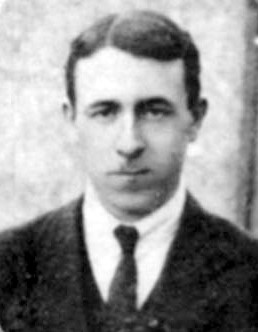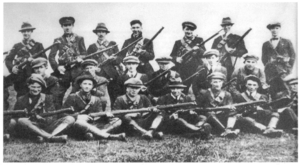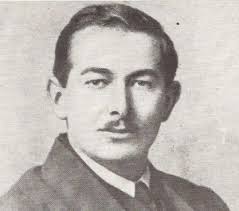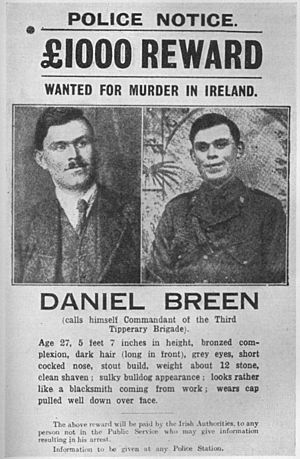3rd Tipperary Brigade facts for kids
The 3rd Tipperary Brigade (Irish: Tríú Briogáid Thiobraid Árainn) was a very active group of Irish fighters. They were part of the IRA during the Irish War of Independence. This brigade was based in southern Tipperary, Ireland. They mostly carried out their actions in the middle part of Munster.
In late 1918 and early 1919, members of the brigade met in a small hut in Greenane, Tipperary. There, they planned the Soloheadbeg Ambush. This event is seen as the first action of the Irish War of Independence. Early in the war, four members of the brigade became the most wanted men in Ireland. They were called the 'Big Four'. These were Seán Treacy, Dan Breen, Séumas Robinson, and Seán Hogan. The brigade's actions, including raids and ambushes, made it very hard for the British to control South Tipperary in 1920 and 1921. The Royal Irish Constabulary (RIC) police stayed mostly in their barracks. The British Army only moved around in large groups for safety.
Contents
Why the Brigade Formed
The years between the Easter Rising of 1916 and the start of the war in 1919 were tense. Many Irish people wanted independence. They felt strongly against the RIC police and the British government. More and more people joined Irish volunteer groups. These groups held meetings and practiced military drills openly. Many political activists were sent to jail. The RIC also raided homes of activists.
In 1918, things became even more serious. A law called the Military Service Bill made it legal to force Irish men to join the British army. Also, groups like Sinn Féin and the Irish Volunteers were banned. This made many Irish people even more against British rule. Sinn Féin won a huge victory in the 1918 General Election. People also held big protests against being forced into the army. Some people in the independence movement believed that only fighting the British would bring freedom to Ireland.
By 1917, volunteers in South Tipperary were forming into groups. They practiced drills and learned how to use guns. They also raided places to get weapons. Seán Treacy was a key leader in these activities. He often visited local groups with Dan Breen. Many activists were jailed for drilling or singing banned songs. These jails became like schools for revolutionaries. Men from all over Ireland discussed how to gain their country's freedom.
Séumas Robinson, who had fought in the 1916 Easter Rising, came to Tipperary in 1917. He joined Eamon Uí Dubhir and Maurice Crowe. These men, along with Treacy and Breen, were important leaders of the volunteers in South Tipperary.
Starting the Brigade
The Third Tipperary Brigade, also known as the South Tipperary Brigade, officially started in 1918. In October 1918, a meeting was held to choose leaders. It took place at P.J. Moloney's house in Tipperary Town. P.J. Moloney later became a Sinn Féin Member of Parliament. British forces burned down his house during the war. All three of Moloney's sons were members of the brigade.
At the meeting, Séumas Robinson was chosen as the O/C (Officer Commanding). Seán Treacy became the Vice O/C. Dan Breen was the Quarter Master, and Maurice Crowe was the Adjutant. The Brigade first had six groups called Battalions. Later, it grew to eight. These were in areas like Rosegreen, Cashel, and Clonmel.
After Seán Treacy was released from prison in mid-1918, he, Breen, and Seán Hogan set up their main base. It was in a small 'Tin Hut' in Greenane. Here, they tested explosives and planned their actions. Many important members of the Brigade often met at the 'Tin Hut'.
The Soloheadbeg Ambush
The ambush at Soloheadbeg is often seen as the start of the war. It was led by Séumas Robinson, Seán Treacy, Dan Breen, and Seán Hogan. Two police officers from the Royal Irish Constabulary were killed during the attack. Their names were Constable Patrick O'Connell and Constable James McDonnell.
The plan for Soloheadbeg was made in the 'Tin Hut'. Treacy, Breen, and Hogan had been testing explosives there. They were looking for ways to attack the RIC. Treacy really wanted to start fighting. He believed that a military fight was the only way to make Ireland a free Republic. In December 1918, they learned that explosives were being moved from Tipperary Town barracks to a quarry.
Treacy asked his commanding officer, Séumas Robinson, for permission. Robinson agreed without asking the main headquarters in Dublin. He thought it was better to act quickly.
They started planning to stop the explosives. Dan Breen's brother, Lars, worked at the quarry. He told them the explosives would be moved around January 16, 1919. They expected two to six armed police officers to guard the explosives. They planned to fire if the police did not surrender right away. Robinson, who was back with the Brigade, supported the plan. He agreed they should not wait for permission from Dublin.
The people involved in the ambush were the four officers: Seán Treacy, Dan Breen, Seán Hogan (who was only 17), and Séumas Robinson. Five other volunteers joined them. These were Tadhg Crowe, Patrick McCormack, Paddy O'Dwyer, Michael Ryan, and Seán O'Meara.
From January 16 to January 21, the men waited in their positions each day. On January 21, around noon, Patrick O'Dwyer saw the group leaving the barracks. The explosives were on a horse-drawn cart. Two council workers were leading the cart, and two armed RIC constables were guarding it. O'Dwyer quickly cycled to tell the ambush party.
Robinson and O'Dwyer hid in front of the main group. When the cart reached the main ambush spot, the volunteers called for the police to surrender. Masked men appeared with their guns ready. The two constables took firing positions. The volunteers then fired at them. Both police officers, Patrick O'Connell and James McDonnell, were killed. As planned, Hogan, Breen, and Treacy took the horse and cart with the explosives and left quickly. They hid the explosives in a field. They also left a few sticks of explosives on the road as a trick. The explosives were moved several times and later shared among the brigade's groups.
Dan Breen later said different things about what they planned to do that day. One idea was just to get the explosives. Another was that they wanted to kill the police to start a bigger fight. He said, "Treacy had told me that the only way to start a war was to kill someone."
However, Robinson said their plan was to ask the police to surrender if there were only two of them. But if there were six police, they would attack. This was because eight IRA men with only one rifle and some revolvers would be outmatched by six armed police.
On the Run
After the Soloheadbeg ambush, a special law called martial law was put in place in County Tipperary. This meant the army had more power.
Treacy, Breen, and Hogan met with Robinson a few weeks later. The "Big Four" stayed in hiding for months. They moved from house to house of people who supported them. Sometimes, they slept outdoors. Treacy and Robinson went to Dublin to meet Michael Collins. Collins offered to help them escape to America. But they said no. They wanted to stay in Ireland and keep fighting.
Hogan, who was only eighteen, was arrested by the RIC in May 1919. His capture led to a very dramatic event. Robinson, Treacy, and Breen, with help from other fighters, rescued Hogan. He was handcuffed on a train guarded by four RIC officers at Knocklong station in Limerick. Hogan would likely have been executed if he hadn't been rescued. Two RIC officers were killed in the fight. Breen and Treacy were seriously hurt. The four men then went to the nearby home of the Foley family. Two years later, Edmond Foley, a son from that house, was executed because he was suspected of helping Hogan escape.
Robinson, Treacy, Hogan, and Breen moved to Dublin. They did many missions for the leaders there. Some of these missions were with a group called The Squad. Robinson, and later Hogan, returned to Tipperary to keep fighting the British and the RIC. Treacy was killed in a gunfight with a British secret agent in Talbot Street, Dublin. Breen moved between Tipperary and Dublin as the fighting continued.
Attacks on Police Barracks
After the "Big Four" were hunted, the rest of 1919 was fairly quiet in South Tipperary. But this changed in early 1920. The different groups of the 3rd Tipperary Brigade started many attacks on RIC police barracks. These included attacks on barracks in Hollyford, Drangan, and Cappawhite.

Robinson continued to lead the brigade through the rest of the war. In September 1920, he made Dinny Lacey the leader of the brigade's first "flying column." A flying column was a small, mobile group of fighters. Later that year, a second flying column was formed with Seán Hogan as its leader.
The Civil War
The Treaty caused big disagreements within the Brigade. Some members supported the new Irish government, called the Provisional Government (later the Irish Free State). Others stayed neutral during the Civil War that followed. Most members, including leaders like Séumas Robinson, Dan Breen, Seán Hogan, and Dinny Lacey, sided with the Republican side. Dinny Lacey was killed in a fight against Free State troops in 1923. Robinson became a General during the Civil War. Breen and Hogan were both held prisoner by the Free State Army during the Civil War.
Remembering the Brigade
A special memorial at St Michael's Cemetery in Tipperary Town lists the names of brigade members who died in the War of Independence and the Civil War. There are many other memorials, plaques, and statues in Tipperary and nearby areas. These remember members of the brigade or their actions. You can find them at places like Soloheadbeg, Knocklong, and Talbot Street, Dublin. The Seán Treacy Memorial swimming pool in Tipperary Town also has information and items from the brigade.
Several songs remember the events and members of the brigade:
- "The Galtee Mountain Boy" – This song mentions three members of the Third Tipperary Brigade: Dinny Lacey, Seán Hogan, and Dan Breen.
- "Tipperary So Far Away" (Ballad of Seán Treacy). This song tells the story of Seán Treacy's death.
- "Ballad of Dan Breen"
- "Station of Knocklong," which is about Seán Hogan's rescue.






